Polarion ALM 21 R1 – What’s New and Noteworthy
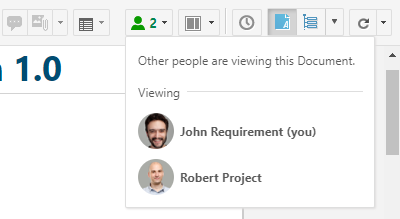
Polarion ALM 21 R1 is available
In this release, we deliver significant collaboration enhancements to existing functionality, based on feedback from our customers who use our solutions every day, as well as usability and performance improvements.
Significant enhancements were done to the following:
- LiveDoc Collaboration – You can now see how many people are working concurrently on a Document, and conflict merging is improved.
- User Authentication – This release brings a major rework of user authentication, including the possibility to authenticate against multiple providers.
- Improvements to Connectors – ReqIF auto-mapping, planning data sync with Jira, and more.
Let’s take a deep dive into all improvements the new release brings.
Collaborative LiveDoc Editing
Collaboration Notifications
In order to help improve collaboration between users and be aware of potential concurrent edits, Polarion has been enhanced to provide a visual notification when multiple users have the same LiveDoc open for editing. We call these Collaboration Notifications. These notifications are pushed to users so they do not have to refresh their browsers to get the latest status.
- A new icon in the Document Editor toolbar shows the number of people working with the Document, so the users can see whether they are the only person working with the Document (the green status with the “You” caption), or whether there is a risk of potential conflicting changes because there are other people in the same Document. (The green status with a number).
- Clicking the icon displays a list of people concurrently working on the Document.
- The Icon is disabled and greyed out if the Notification service is offline.
In 21 R1 the feature only shows users working on the same Document, but does not show details about their actions. However, stay tuned. Different statuses for reading (green), editing (orange), and saved changes (red) by other users in the same document are planned for a future release.
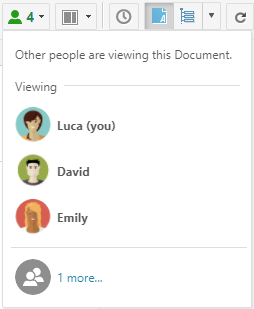
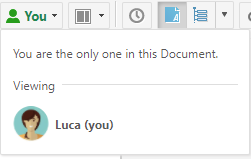

In the examples above, the first screenshot (from left to right) shows 4 users with the Document open, the second screenshot shows just a single user with the Document open, and the final screenshot shows that there is no connection to the Collaboration Notification Service or it is offline.
This video is a demo of the Collaboration Notification feature in action with four users working in parallel on the same document.
It should come as no surprise to you all that we use Polarion ourselves to author this blog in a LiveDoc. This involves many of our team members contributing to the content simultaneously. We found the new collaboration notification feature incredibly useful to better understand which users were currently working on content for the blog post in real-time!
Merge Conflict Improvements
To complement the Collaboration Notification feature, we also made some LiveDoc improvements concerning concurrent edits.
First, we improved the way Polarion automatically merges concurrent structural changes: moving, indenting, adding, or removing items, headings, and paragraphs within a Document. Let’s say multiple users reorder items in different parts of the Document. This no longer results in a hard conflict, and now Polarion is able to safely merge such changes. Also, during the reporting of a conflict, we indicate in the concurrent changes dialog, the type of conflict (structural in nature vs. content changes). This helps users to better understand the conflict being reported.
Second, the concurrent changes warning dialog has been completely overhauled. As noted, the type of conflict reported is improved. But, you will also notice distinct red and yellow coloring to indicate whether Polarion can safely merge changes or not. Yellow means the concurrent change can be safely merged, but it is recommended that the user review the change before saving the Document. Red means that the concurrent changes are a “hard” conflict that will result in an unsafe merge where Polarion will overwrite an earlier edit, and the user will be required to manually merge back any relevant changes.
Finally, we have added explanatory tooltips to better help the user understand the implication of conflicts, which users made changes, and to improve overall logging when concurrent changes occur.
Example: Concurrent structural changes detected where Polarion can safely merge changes on saving.
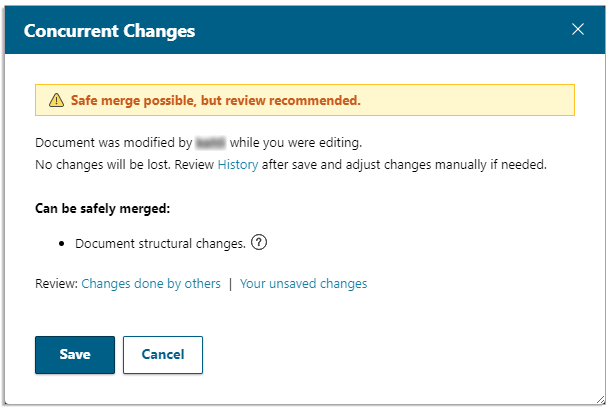
Example: Concurrent content changes detected where Polarion cannot safely merge changes on saving. If the user saves the Document, some content will be overwritten, and the user will need to manually merge back any earlier changes. Also, note in this example, there were structural changes made to the Document, but they can be safely merged.
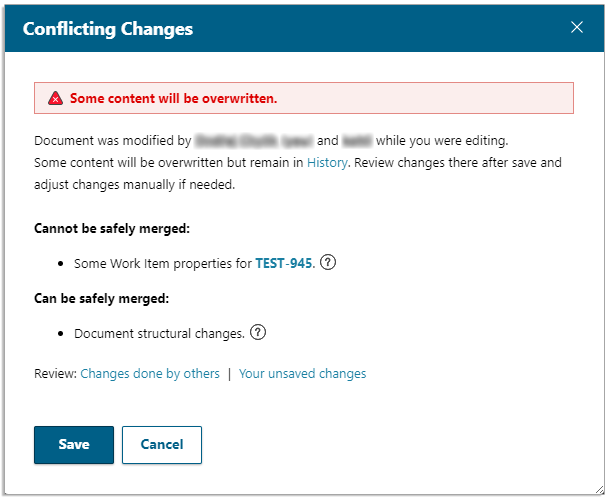
Authentication against multiple providers
The authentication methods in the new release have been almost completely reworked to bring a number of benefits to our customers and align the configuration of the different authentication providers. The most notable benefit of the new configuration is the possibility to use multiple authentication providers simultaneously, and configure Polarion so that different users can log in with different providers. This functionality unlocks a whole lot of new options for our customers. They can:
- Invite their suppliers or customers into their Polarion instance for reviews and collaborations, while authenticating the external users against their own respective cloud identity providers.
- Use multiple LDAP servers for authentication.
- Create locally authenticated service user accounts that allow external tools to connect to Polarion.
(Without having to set them up in the company’s identity management system.)
Here are some more improvements unlocked by the new authentication:
- Admins have greater control over the behavior of each authentication provider or LDAP configuration, so e.g. auto-create can be only enabled for specific authentication methods.
- Authentication can be configured via a new Authentication administration page through a syntax-aware XML editor with extensive validation that helps you configure everything right.
- The update of encryption certificates for SAML Single Sign-on is now seamless. Polarion now supports multiple certificates for a single SAML authentication provider, so you can update your expiring certificate way ahead of time.
- LDAP-bind passwords and oAuth client secrets can be stored in the user account vault where they’re safely encrypted.
- Account vault keys can be updated via the web services API. This allows your IT operations team to use their favorite DevOps tool to renew service account passwords when they expire.

A reconfiguration will be necessary for most existing Polarion deployments when updating to 21 R1. Before updating to this release, please review the new Authentication guide on Support Center.
Important things to know:
- A new configuration is required for all deployments that use any means of LDAP authentication. Without a new configuration, your Polarion instance will not be accessible.
- Authentication using the password, OAuth 2, and SAML methods are temporarily backward compatible, but it is strongly suggested that you reconfigure them via the new configuration.
- The Kerberos and Teamcenter Security Services (TcSS) authentication methods must be still configured via system configuration properties in the polarion.properties file, and do not support combinations with other authentication sources.
- If you use a Cluster setup with load balancing, you will have to adjust your Apache configuration. In a Cluster setup, these changes should be made after updating all machines that run the Polarion service.
Instead of the passwd file, a new passwd_credentials file now stores local passwords for local users. The passwd file still exists but is now exclusively used to store system-generated secrets for internal Polarion processes.
- Administrators that made custom modifications to the
passwdfile prior to 21 R1 should apply them to thepasswd_credentialsfile instead. - Any modification done to the
passwdfile will be overwritten by the internal Polarion processes anyway. - If you use external services that connect to the /repo location, connect them instead to a new /repo-access custom location that is authenticated against the
passwd_credentialsfile. The /repo becomes a system internal location by default and binds to thepasswdfile. Please refer to the Direct SVN access help for details on how to customize the configuration.
Per-field permissions for LiveDocs
In order to set up a robust process and workflow for Documents, the permission schema for Live Docs has been enhanced with per-field permissions. Similar to the existing Work Item functionality, the value for Status and custom fields can be selectively made read-only, or hidden completely. The entire configuration is available under Documents in the Permission Management section.
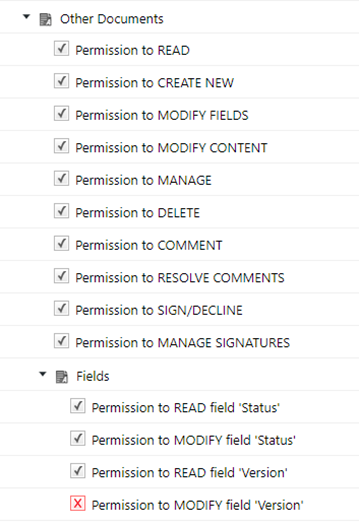
Custom sets can be configured to reflect the different process stages of your Document workflow. Once the Document reaches a specific maturity stage, its fields can be locked to prevent their modification by specific roles. So now it is much easier to achieve the following scenarios:
- Assign a unique Document ID when a Document is created that should never ever be changed.
- Set up a Document version field, that increments only during a certain workflow step by a script action, but is not editable by other means.
- Once a Document is Approved, you can prevent the modification of its Version, Owner, and Risk Assessment.
- Ensure that specific Document information fields like QA Assessment can only be edited by your Quality Manager.
Custom attributes for Test Records
Our customers often use Polarion to manage the verification and validation of their cyber-physical products. Testing a physical product often requires a specific infrastructure and tools that support their testing. Test Management in Polarion has been improved with such customers in mind by extending test execution data with custom attributes.
The custom attributes allow you to track additional structured information during or even prior to test execution, such as:
- Serial IDs of the test equipment used for testing.
- Voltage, temperature, or flow rate measured during the test.
- A tester responsible for executing a particular test case.

Keeping such records in a structured format enables more robust process control and validation for test executions. It also allows for easier reporting on top of the verification data, which provides additional insights and potential productivity improvements to a customer’s verification procedures.
The custom attributes are configured via a new Test Record Custom Fields administration page. The attributes can be filled in via the Test Execution view, or set via APIs and later displayed on the Test Records view, and in the Test Records Widget.
Connector Improvements
ReqIF Auto-mapper
From talking with our customers we know that a large number of you use the ReqIF import and export capabilities of Polarion. We also hear from you that when you need to import ReqIFs that contain several documents and many attributes it takes time to set up the required ReqIF mappings. So we introduced the ReqIF Auto-mapper for imports.

The ReqIF Auto-mapper provides a two-step process. First, all Work Item types contained in the ReqIF file can be conveniently mapped to Polarion Work Item types:
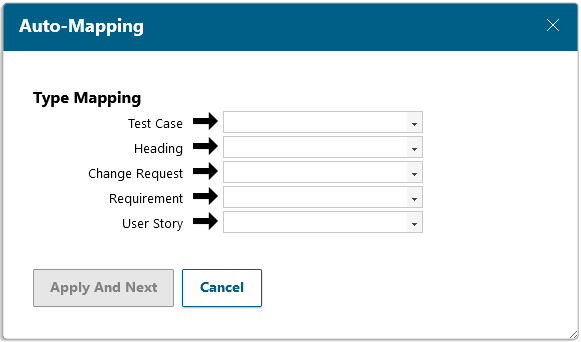
Second, an aggregated list of all attributes of all ReqIF Work Item types is presented so they can be mapped to Polarion attributes:
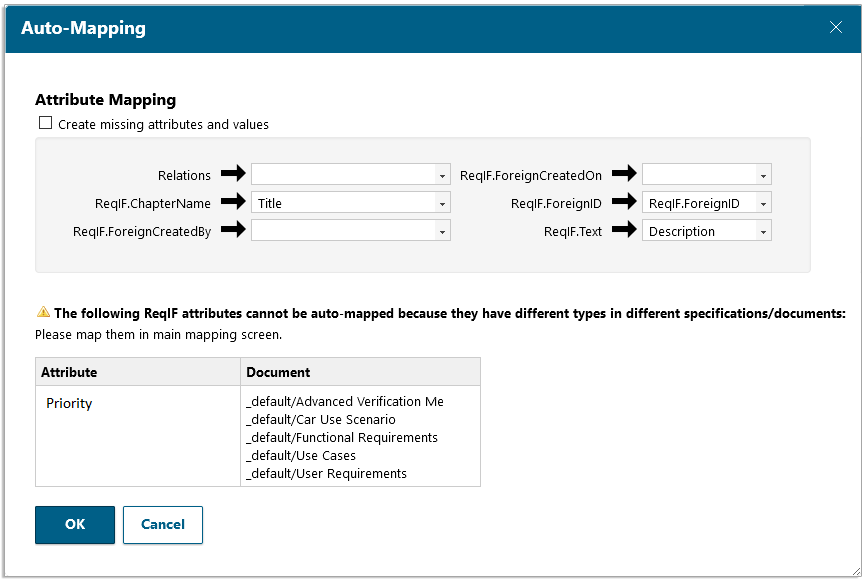
Notice the Create missing attributes and values option? If selected, a custom field is created for every unmapped field, including enumerations and their values.
Synchronize planning data with Jira
Polarion 21 R1 introduces the automatic synchronization of planning data between Polarion (field Planned In) and Jira (field Fix versions). This means that Polarion Plans and Jira Versions are automatically created, updated, and deleted if they are referenced in the field Planned In or Fix versions. The configuration is similar to the Work Item type mapping:

For this type mapping, the following attributes are supported:
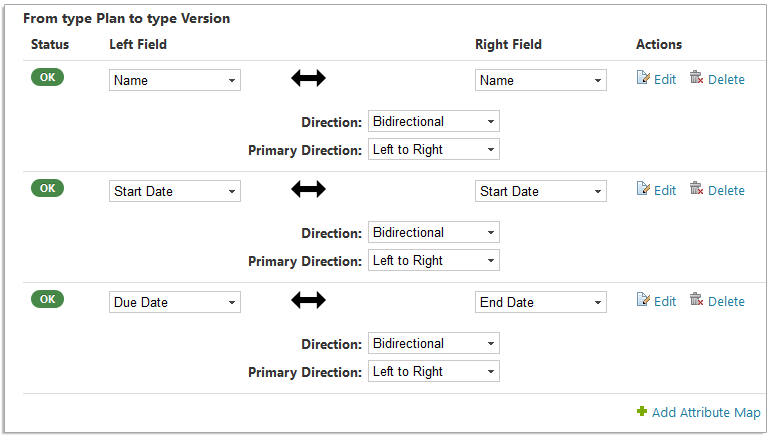
Retain local attachments on synchronized Work Items
Assume that Requirements are synchronized one-way from your customer to your R&D department, and you add attachments to these Requirements for internal use. Then these attachments are deleted every time you synchronize with your customer, simply because they do not exist on the customer side and the synchronization is one-way. With Polarion 21 R1 you can change this behavior and configure it so that these local attachments are retained:

Configurable attributes for federated links
Until now, attributes of linked Work Items in remote systems were accessible only by hovering over the link and looking it up in the preview. To make it easier, we introduced a mechanism that puts the information where you need it. In the Work Item form:
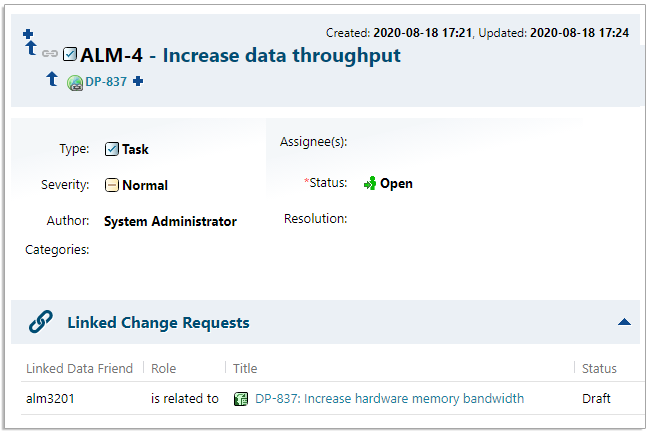
In this example, a new section has been added to the Work Item form using the Form Configuration. In this new section, a specific type of linked Work Items is shown (Change Requests) and for each of the items, you can directly view their Status.
No more link hovering and preview skimming! The number of sections, its Work Item types, and attributes to show can be configured. In the following example, you see more attributes configured, like User, Date, and more:

Connector robustness and scalability improved
A number of improvements have been made concerning connector robustness and scalability which is applicable across the different integrations Polarion offers. These improvements can be summarized as follows:
- Enhanced logging for easy monitoring and troubleshooting: The connectors log files clearly show what is happening at each stage of the synchronization and provide clearer messages and hints to resolve problems. This enables our customers to resolve synchronization issues more effectively.
- When the synchronization of data fails because of temporary network hiccups, valuable time is lost. To mitigate this we introduced retry support to make syncing more robust and resistant against network communication errors. The number of retries and the delay between them is configurable.
- To reduce memory allocation we implemented an improvement so that attachments are kept in memory only when needed.
Enhancements
Collection Improvements
With Collections being the latest major addition to the group of Polarion first-class citizen object types, our teams continue to enhance and complete their feature set. The following improvements were addressed in Polarion 21 R1:
- Collection type is made available in the Table widget in Live Reports for an easy listing of Collections in the reports.
- Custom fields of type Enumeration are available for Collections. The multi-valued enumeration field support is not available yet, but coming in future releases.
- Pasting a URL of Collections and Baselines into the rich-text editor creates a Live link, which allows you to easily reference Collections in other artifacts.
Usability Improvements
We receive a lot of feedback from our customers about how to improve Polarion further and we try to address some of the usability feedback in every release of Polarion. The following improvements have been selected this time:
- The new Control Chart widget got support for the visual Query editor or Query Bubbles as we call them internally. This improvement also drove the introduction of a new Lucene Query type widget parameter. It has a visual query editor, that is available in the UI and separate from the Data Set parameter.
- A Collapse All action has been added to the Document Outline sidebar, so users can easily collapse the whole Document structure when navigating across large LiveDocs.
- On top of being able to insert referenced Work Items, Users assigned the QA license can now also freeze/unfreeze referenced Work Items.
Administration Improvements
The new cumulative patches introduced in the 20 R1 release were very welcome by Polarion administrators. As of Polarion 20 R2, to make patch deployment easier for admins, we turned them into mini releases. They are distributed like full Update package with their own build ID. This lets administrators easily determine the patch version from the Polarion user interface.
We also made it easier for administrators to collect feedback from end-users. Just like we do, many Polarion admins track internal feedback and requests for improvements in a dedicated Polarion project. The Send feedback action on the left Configuration panel has a custom target configurable via a new property.
A new version of Tomcat has been introduced to the Polarion platform, which adds additional ways to secure a Polarion deployment. The communication between Apache HTTPD and Polarion’s Tomcat AJP port can be now configured to require a secret token.
Performance and Scalability
A quick and responsive system is key to good usability and end-user satisfaction. In this release, we put effort into improving both specific UI actions as well as overall backend performance in three different areas.
On the front-end side, the loading of the Document structure in the Move Work Item dialog has been reworked to leverage the proven logic used in the Document Outline sidebar. This resulted in a significant improvement of Document structure loading in the Move Work Item dialog to less than a second.
Next, the communication with our backend Subversion persistence was optimized as part of the overall authentication improvement effort. Especially for the Single-sign-on environments, the operations that are heavier on Subversion communication provide significantly better performance. Our tests on real-life Documents show that:
- Initial imports of Documents from different sources were improved from 22% to 57%.
- Round-trip imports of Documents were improved between 15% and 31%.
- Saving changes in a Live Document is 13% to 38% faster.
- Write operations are 26% to 36% faster during load tests with 2000 concurrent users on 10,000,000 Work Items repository.
The second improvement was done to the transformation and caching of object enumerations that are used in built-in and custom fields. (For example, Assignee, Author, custom fields that list Users, Documents, or Test Runs.) These enumeration options are heavily used throughout the whole application. The smarter reuse of available enumeration options lead to improvements in displaying the editors for these fields, and faster loading of the global query panel. (Especially in environments that define a lot of these custom fields.)
The last major improvement was done to the indexing of objects with long histories. Manual Test Runs can have thousands of historical revisions. This took a long time to process for indexing. Improved caching and other optimizations reduced the indexing time for Test Runs with long history by two magnitudes.
Another significant improvement for the indexing of objects with long histories is still ongoing, but can already be enabled by setting the com.siemens.polarion.cache.skipHistory.enable=true Polarion property.
This switch enables more intelligent caching that significantly reduces the volume of historical data requested from Subversion. Clustered and cloud environments that have generally slower access to Subversion data due to network communication will especially benefit from this new optimization. However, use this new optimization with caution and report any problems and feedback through our technical support portal.
Technology Maintenance
On top of the many functional and non-functional improvements, our teams also delivered a number of technology updates:
- The Live Plan view in the Work Items topic has been removed together with the old Flash-based visual component. We retained the Live Plan calculation job that can still be used to calculate the Work Item planned start and end dates and the Live Plan XML representation. Customers that need to visualize the old Live Plan can leverage a new commercial addition to Polarion Extensions.
- Polarion Variants binaries have been updated to leverage the latest pure::variants updates. It is now compatible with the latest version of pure::variants and its performance and reliability have been improved.
- Subversion 1.14 LTS has been added to the versions supported by Polarion. Updated Subversion and Apache binaries have been provided for Windows deployments.
- Ubuntu 20.04 LTS has been added to the supported operating systems. Ubuntu 16.04 LTS has been dropped.
Notable Issue Fixes
The new release also delivers a number of quality improvements and defect fixes, where the most important ones have been packaged into cumulative patches for the previous Polarion 20 R2 version.
The full list of Resolved Issues is available in Support Center. The most notable issues are listed below.
DPP-79913 – Rows in Traceability and Variants Compare Matrix misaligned when rescaling in Chrome (20 R2 P2)
DPP-92725 – PDF Export is losing imported UTF-8 characters (20 R2 P1)
DPP-117855 – Cannot round-trip moved LiveDoc that has overlapping location with other LiveDoc (20 R2 P2)
DPP-118222 – Updating derived document fails with NPE if source Work Item was deleted
DPP-121051 – Pasting unformatted text in table (in description of WI) will remove formatting in cells which are already formatted
DPP-125195 – Work items without author cause NPE if lazy load ON
DPP-205981 – Missing Spaces in navigation panel in Baseline view (20 R2 P1)
DPP-211194 – User sessions occasionally don’t expire due to stale webapp (20 R2 P1)
DPP-216354 – Jenkins Connector: Persisted reference to build is missing after removing connection
DPP-217714 – Jenkins connector does not support builds longer than 24 hours (20 R2 P2)
Update Information
Version 21 R1 is a free update to all customers with a current maintenance subscription. You can download the update distribution at Support Center. Instructions for installing it are in the HOW_TO_INSTALL_THIS_UPDATE.txt file, bundled in the update distribution package. Please also review the Configuration.txt file, which describes changes that can affect existing Polarion installations.
Evaluation
If you would like to evaluate this release before updating your production installation, simply visit Polarion Trial Download, download the product, install it, and use the built-in 30-day evaluation license.
If you have any questions or comments, please don’t hesitate to contact us on the Polarion Community portal or through your Polarion technical support contact. On behalf of our entire team, thank you for using Polarion ALM.
Regards,
Radek Krotil,
Polarion ALM Product Management
Comments
Leave a Reply
You must be logged in to post a comment.



There are a lot of nice improvements, collaborative view in the LiveDocs and also the faster loading of “Assignee” field, but how much faster this field will be loaded?
But for every new release I wish that the LiveDoc and Workitem Editor get an update. It is a shame that you have to click 3 or 4 times to color a text.
And if I wanna dream, a HTML based rich-text field would be awesome 🤤.
There are a lot of nice improvements, collaborative view in the LiveDocs and also the faster loading of “Assignee” field, but how much faster this field will be loaded?
But for every new release I wish that the LiveDoc and Workitem Editor get an update. It is a shame that you have to click 3 or 4 times to color a text.
And if I wanna dream, a HTML based rich-text field would be awesome 🤤.